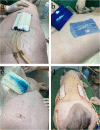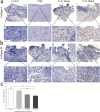Recombinant human epidermal growth factor combined with vacuum sealing drainage for wound healing in Bama pigs
- PMID: 33685528
- PMCID: PMC7941968
- DOI: 10.1186/s40779-021-00308-5
Recombinant human epidermal growth factor combined with vacuum sealing drainage for wound healing in Bama pigs
Abstract
Background: Vacuum sealing drainage (VSD) and epidermal growth factor (EGF) both play an important role in the treatment of wounds. This study aims to explore the effects of the combination of VSD and EGF on wound healing and the optimal concentration and time of EGF.
Methods: We tested the proliferation and migration capacity of HaCaT and L929 cells at different EGF concentrations (0, 1, 5, 10, and 100 ng/ml) and different EGF action times (2, 10, and 30 min). A full-thickness skin defect model was established using male, 30-week-old Bama pigs. The experiment included groups as follows: routine dressing change after covering with sterile auxiliary material (Control), continuous negative pressure drainage of the wound (VSD), continuous negative pressure drainage of the wound and injection of EGF 10 min followed by removal by continuous lavage (V + E 10 min), and continuous negative pressure drainage of the wound and injection of EGF 30 min followed by removal by continuous lavage (V + E 30 min). The wound healing rate, histological repair effect and collagen deposition were compared among the four groups.
Results: An EGF concentration of 10 ng/ml and an action time of 10 min had optimal effects on the proliferation and migration capacities of HaCaT and L929 cells. The drug dispersion effect was better than drug infusion after bolus injection effect, and the contact surface was wider. Compared with other groups, the V + E 10 min group promoted wound healing to the greatest extent and obtained the best histological score.
Conclusions: A recombinant human epidermal growth factor (rhEGF) concentration of 10 ng/ml can promote the proliferation and migration of epithelial cells and fibroblasts to the greatest extent in vitro. VSD combined with rhEGF kept in place for 10 min and then washed, can promote wound healing better than the other treatments in vivo.
Keywords: Epidermal growth factor; Full-thickness skin defect; Skin wound healing; Vacuum sealing drainage.
Conflict of interest statement
The authors declare that they have no competing interests.
Figures







References
Publication types
MeSH terms
Substances
LinkOut - more resources
Full Text Sources
Other Literature Sources

